![]()
|
James
Broadhurst & Sons |
Location and period of operation:
|
James Broadhurst |
Longton |
c. 1860 |
c. 1870 |
|
James Broadhurst |
Fenton |
c. 1870 |
1894 |
|
James
Broadhurst & Sons |
Fenton |
1894 |
1922 |
|
James
Broadhurst & Sons |
Fenton |
1922 |
1939 |
|
James
Broadhurst & Sons |
Fenton |
1939 |
1959 |
|
James
Broadhurst & Sons |
Fenton |
1959 |
1984 |
Earthenware manufacturer at the
Crown Works, Longton and then from 1870 at the Portland Pottery,
Fenton. Stoke-on-Trent, England.
|
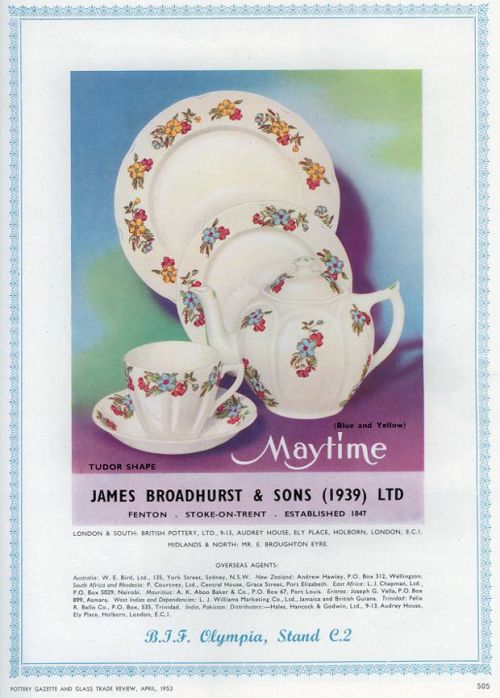 James Broadhurst & Sons (1939) Ltd Fenton . Stoke-on-Trent . Established 1847 Pottery Gazette and Glass Trade Review - April 1953 |
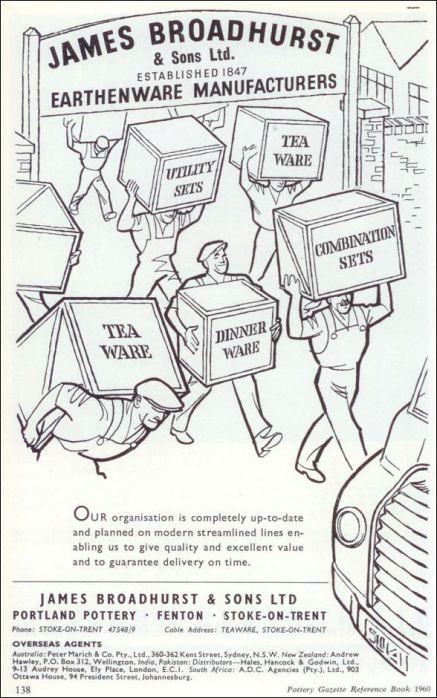 James Broadhurst & Sons Ltd Established 1847 Earthenware manufacturers Portland Pottery . Fenton . Stoke-on-Trent Pottery Gazette Reference Book - 1960 |
The "established 1847" refers to the
company of Hampson, Broadhurst and Broadhurst
Kathie Winkle
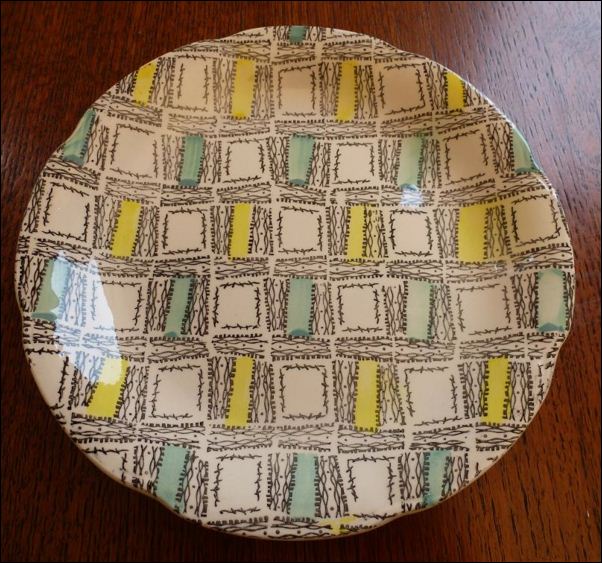
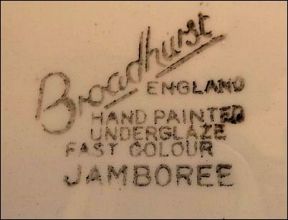
plate in the Jamboree pattern
by Kathie Winkle
design from c.1960
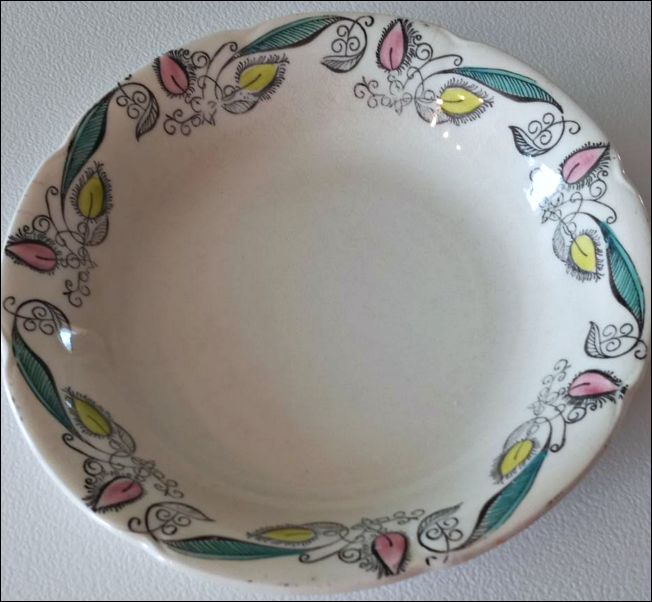
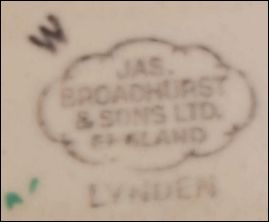
plate in the Lynden pattern
by Kathie Winkle
c. 1958-64
photos courtesy: Hélène Giguère
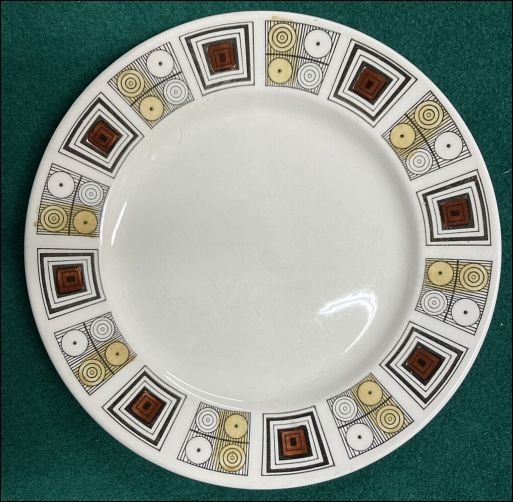 Rushstone by Kathie Winkle
|
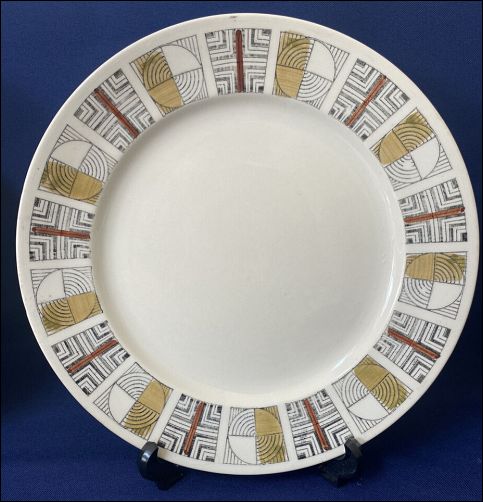 Concord by Kathie Winkle
|
| Kathie Winkle - pottery
designer Kathie Winkle began her pottery career at Shorter and Son, Stoke-on-Trent, where she was trained as a paintress. She joined James Broadhurst & Sons Ltd., Portland Pottery, Fenton around 1950, initially as a paintress, but by 1958 she was producing her own designs. She soon became responsible for all Broadhurst’s pattern designs from then until the mid 1970s. The removal of post-war restrictions on the designers created a demand for new styles of kitchenware and Broadhursts were able to use Kathie Winkle’s ideas to meet this new market.
During her time as a designer Kathie Winkle produced over 100 patterns. The shapes of the ware did not change. Simple forms proved a more suitable background for frequent pattern changes. It was also much cheaper to change the surface pattern rather than the shape of the pot and so a standard shape range was used. In addition, only a small number of colours, usually three or less, were used on each piece to reduce the cost of production. The fewer the strokes of a paintress’s pencil (brush), the better.
Her name appears on the backstamp from 1964 and became the registered trademark for Broadhursts’ wares. It was also used from then on any pre-Winkle designs which were re-issued. This backstamp was used until around 1978 when she changed role within the company.
|
Initials and marks used on ware for identification:
|
Note: the pottery company of James Beech & Son also used the initials J B & S (and J B & Son) - their mark included a crowned Stafford knot with these initials.
J B & Son this is the mark of James Beech & Son |
J. B.
c. 1860-70
J. B. & S.
1870-1922
J. B. & S. Ltd
1922+
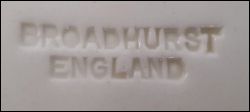
BROADHURST
ENGLAND
impressed mark
post war (c. 1945+) included the name in full
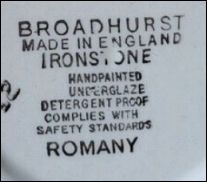
c. 1958-64 |
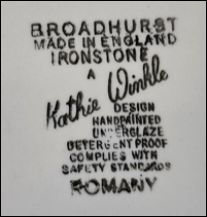
c. 1964-78 |
|
Kathie Winkle was producing her own designs by 1958. However her name didn't appear on the backstamp until 1964 - it then became the registered trademark for Broadhursts’ wares. The Winkle backstamp was also used from then on any pre-Winkle designs which were re-issued. This backstamp was used until around 1978 when she changed role within the company. |
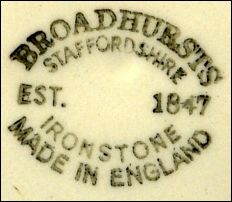
Broadhurst
Staffordshire
Est. 1847
Ironstone
England
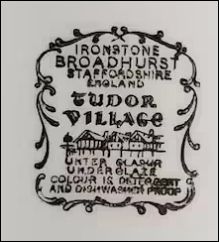
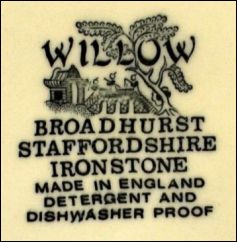
marks with the phrase 'Dishwasher Proof' are generally 1955 onwards
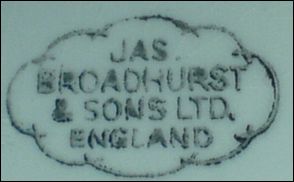
Jas Broadhurst
& Sons Ltd
England
printed mark in use from 1957

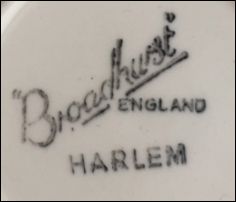
Broadhurst
England
printed mark in use from 1961 onward
often including the pattern name
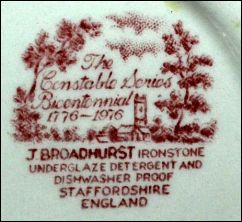 J. Broadhurst Staffordshire England Constable Series |
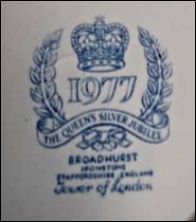 Broadhurst Staffordshire England 1977 Queen's Silver Jubilee |
Questions, comments, contributions? email: Steve Birks